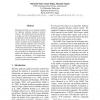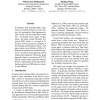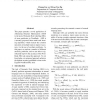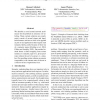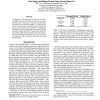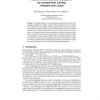88
Voted
EMNLP
2008
15 years 2 months ago
2008
We present a PropBank semantic role labeling system for English that is integrated with a dependency parser. To tackle the problem of joint syntactic
102
Voted
EMNLP
2008
15 years 2 months ago
2008
This paper describes a new automatic method for Japanese predicate argument structure analysis. The method learns relevant features to assign case roles to the argument of the tar...
97
Voted
EMNLP
2007
15 years 2 months ago
2007
In this technical report, we propose the use of Lexicalized Tree-Adjoining Grammar (LTAG) formalism as an important additional source of features for the Semantic Role Labeling (S...
110
click to vote
LREC
2010
15 years 2 months ago
2010
Semantic Role Labeling cannot be performed without an associated linguistic resource. A key resource for such a task is the FrameNet resource based on Fillmore's theory of fr...
108
click to vote
COLING
2008
15 years 2 months ago
2008
Almost all automatic semantic role labeling (SRL) systems rely on a preliminary parsing step that derives a syntactic structure from the sentence being analyzed. This makes the ch...
82
Voted
COLING
2008
15 years 2 months ago
2008
In Semantic Role Labeling (SRL), arguments are usually limited in a syntax subtree. It is reasonable to label arguments locally in such a sub-tree rather than a whole tree. To ide...
91
Voted
ACL
2007
15 years 2 months ago
2007
This paper presents a novel application of Alternating Structure Optimization (ASO) to the task of Semantic Role Labeling (SRL) of noun predicates in NomBank. ASO is a recently pr...
106
Voted
ACL
2007
15 years 2 months ago
2007
We describe a novel neural network architecture for the problem of semantic role labeling. Many current solutions are complicated, consist of several stages and handbuilt features...
105
Voted
AAAI
2010
15 years 2 months ago
2010
Parsing plays an important role in semantic role labeling (SRL) because most SRL systems infer semantic relations from 1-best parses. Therefore, parsing errors inevitably lead to ...
91
Voted
CICLING
2008
Springer
15 years 2 months ago
2008
Springer
This paper analyzes two joint inference approaches for semantic role labeling: re-ranking of candidate semantic frames generated by one local model and combination of two distinct ...

